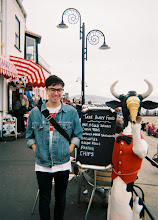A good starting point, the site also includes many useful resources for working out the f/ stop of your pinhole camera and the exposure times it may need.
http://www.pinhole.cz/en/pinholecameras/exposure_01.html
Particularly useful for learning about exposure times, it includes a couple of the formulas used in pinhole photography as well as a description of the Schwarzschild Effect, also knowns as the Reciprocity Law Failure.
The following two links are alternative ways of approaching pinhole photography, the first is a pinhole camera using Polaroid 600 film for instant results whilst the second is about making a pinhole camera out of Lego which uses 120 film.
http://www.flickr.com/photos/duchamp/2177521907/
http://www.foundphotography.com/PhotoThoughts/archives/2005/10/medium_format_p.html
The image below is my homemade pinhole camera, though at the moment it is somewhat garish. The main body is a thick cardboard box bought from paperchase, the hole was punched with a small thumbtack. There are still a few more modifications which I intend to do to it, these are only minor things such as attaching a small nut to the bottom so as to fix it to a tripod, attaching a strap of some sort to it as it is too large to comfortably carry in a bag, and finally to cover or paint the interior and exterior black. The interior must be painted so as to avoid reflection from the red paper which it is lined with otherwise this could fog the image. Painting the exterior is purely cosmetic as I do not want to walk around with a multicoloured argyle-print box.

Another technique which I intend to play with for this project is the Sunprint Kit. This is a kit I purchased a coupe of years ago with light-reactive blue paper which, when exposed to the sun, changes colour to a paler blue or white. The principal is the same as the photogram or rayograph however the paper requires only sunlight to activate it and water to fix the image. The paper is also less light-sensitive than typical photopaper and so requires no darkroom. The images below are of the kit and the results which can be achieved. 


No comments:
Post a Comment